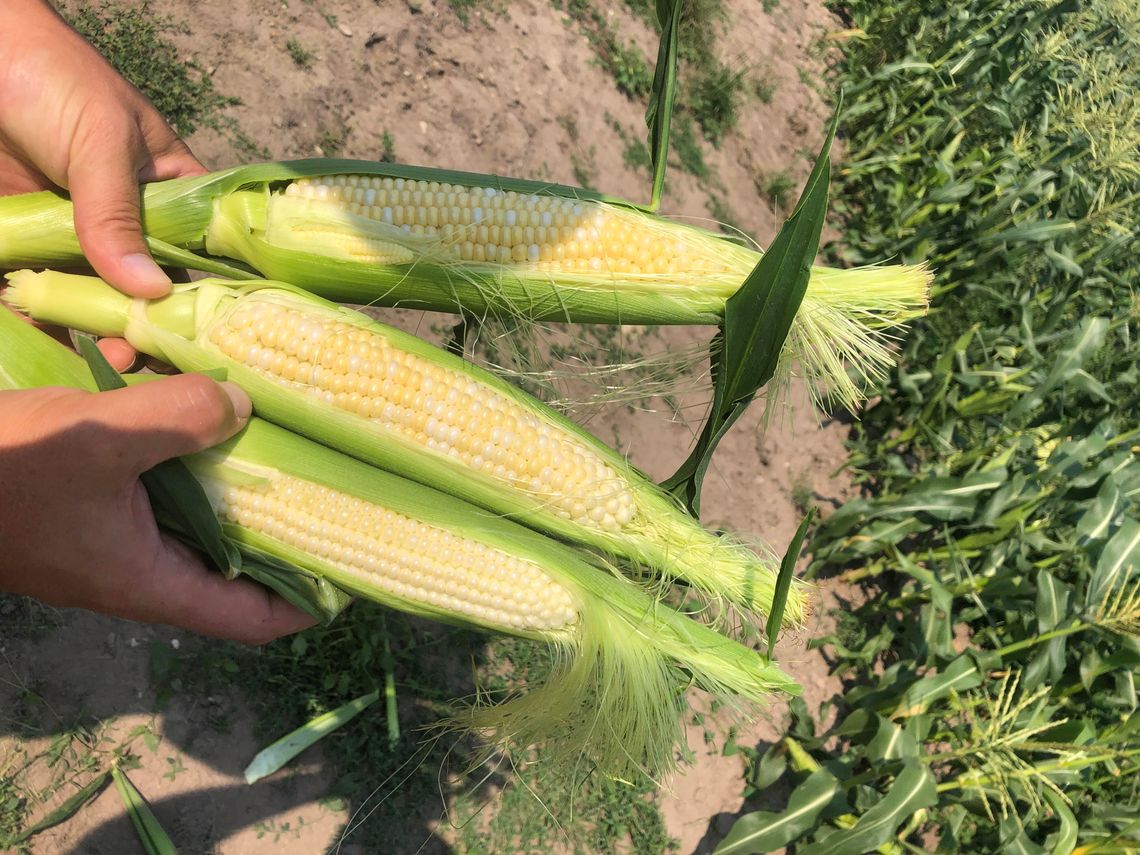Curtis Kelenske looks down half mile rows of tasseled sweet corn, studies for a bit, then pulls down three seemingly random cobs. He pulls back the husks for a deeper gander, then arranges them in order of maturity.
“We’ll have corn on the shelves by Thursday,” he pronounced, garnering approving nods from his family.
Sweet corn season has officially begun in Centerville Township just a few days later than in Kasson Township, where his friend Ryan Noonan last weekend opened Buzzy’s corn stand along M-72.
Curtis, in fact, paid an uninvited visit to the Noonan farm Tuesday morning, He snapped a picture holding a cob next to his T-shirt, which read “Curt’s Corn.”
The good-natured rivalry is underway, too.
“We joke a lot, me and Curt,” Noonan said before jabbing back.”I wouldn’t be selling my corn unless it was better than Curt’s.”
The fact that farmers take their pickings so seriously helps explain why sweet corn season is treasured in Leelanau County. Kelenske, a Leland elementary teacher, has been driving tractor on his family’s 300acre farm since a kid. Some 18 years ago he talked his dad into allotting 10 acres of clay-bottom soil for sweet corn, and he’s been tweaking his growing technique ever since.
Using a four-row John Deere planter from the 1970s, Kelenske plants three times in the spring, lengthening the sweet corn season. He also mixes up his seeds, using early, medium and late varieties.
Here’s a distinction without a difference to most taste buds. Later corn, the kind that’s picked around Labor Day, has a higher sugar content than early varieties. But since consumers have been starved of fresh sweet corn for 11 months, the first ears are often the most coveted.
Kelenske is a treasure trove of corn trivia that helps him make better farming decisions. Early varieties have shorter stems, so they are planted at the outside of rows to allow more light to reach the taller, later varieties. He avoids genetically modified corn, which is easier to grow because it resists weed spray but doesn’t taste as good.
And that clay soil that dominates his corn field found on a back plot east of south French Road is helpful. Even during dry years the soil retains moisture for a crop, while Noonan’s sandy field off M-72 is helped by irrigation.
Oh, and don’t sit on your sweet corn after you buy it. Kelenske figures it only stays prime for three or four days.
The Kelenskes combine work, breakfast and family time. During corn season wife Melissa and Curtis gather up their daughters, Sasha, 11, and Sienna, 7, as part of the picking crew. Sasha at times can be found behind the wheel of a creeping farm truck. Some times Leland School students and Kelenske relatives join in picking corn and delivering it to retail stores and stands that same morning.
Well, most of the corn. A few ears are gobbled up raw, fresher than fresh.
County grocery shoppers will find Curt’s Corn at the Merc, Tom’s, Hansen’s Foods and Oriana in Traverse City. Corn is also available at the Kelenske farm market off French Road and at the Price Farm Market in Lake Leelanau, as well as other locations.
The price hasn’t changed over the past year for Noonan or Kelenske. It’s still $7 a dozen.
Kelenske is a third-generation farmer whose lineage dates back to 1896 — which is unusual if you think about it. That’s because the second generation of Kelenskes took their time.
“This is my parents farm, and before that my grandpa who was born in 1896. He had my dad when he was quite old, like 52 or 54. It’s unusual for two generations to go all the way back to the 1800s. But there were a lot of bachelor farmers around here back then,” Kelenske said.
He credits his parents, Jerry and Anna May, with passing on the bug to farm. The Kelenskes mostly raise cattle for butchering at local stores and hay that fattens their livestock and is sold to nearby farmers.
“He’s the main farmer, and I’m the hobby farmer. I was able to help him on the farm and then I found something to make a little bit of money. I’ve worked on the farm with my dad since I was 10 years old,” Kelenske said with a sense of pride.
With all that attention spent on sweet corn, Kelenske has an opinion on the best preparation.
And that is anyway you like it.
“There is no secret. We always boil it. Melissa and my cousins like it raw. I learned most everything on my mama’s knee. There are people selling who tell you all these different ways to cook it. Some people leave the husk on and put it on the grill. The thing is that all snacks are either sugary or salty, and with sweet corn you combine them. The kids like it because it’s full of sugar.
“No kids are going up to a broccoli stand and saying, ‘Mom, buy this.’”








